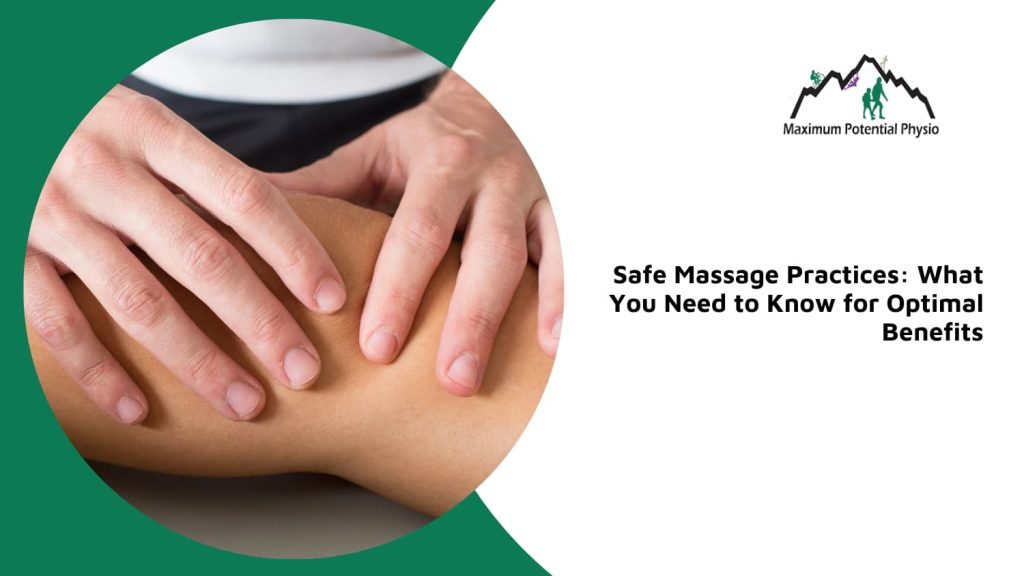Safe Massage Practices: What You Need to Know for Optimal Benefits

Massage therapy is a widely embraced practice for promoting relaxation and aiding in the recovery of muscle tension and stress. It has been used for centuries across various cultures as a therapeutic tool. However, with its growing popularity, many individuals question the safety of massage therapy as a treatment method. In this blog, we will explore the safety aspects of massage therapy, the measures therapists take to ensure client safety, and how individuals can verify the qualifications of their massage practitioners. We will also delve into potential risks or side effects, its suitability for pregnant women, and conditions that might affect its safety.
Is Massage Therapy Considered a Safe Treatment Method?
Massage therapy is generally considered a safe treatment method when performed by a trained and qualified professional. It is known for promoting relaxation, reducing muscle tension, and supporting recovery. However, as with any therapeutic practice, there are certain precautions one should be aware of. Licensed massage therapists are trained to assess individual needs and conditions, ensuring that massage techniques are appropriately tailored. Precautions include understanding a client's health history and being aware of any conditions such as blood clotting disorders or recent surgeries that could affect the safety of a massage session.
Techniques like Swedish massage, deep tissue massage, and aromatherapy are typically safe for most individuals but may need adjustments based on personal health circumstances. In summary, massage therapy is a safe and effective treatment for most people when performed by a professional who considers individual health conditions.
To sum up, massage therapy is safe when administered by a qualified practitioner who tailors the session to the client's health needs, making it an effective option for many seeking relaxation and recovery support.
What Measures Do Massage Therapists Take to Ensure Client Safety During a Massage Session?
Massage therapists implement several measures to ensure client safety during a massage session. These include assessing the client's health condition, maintaining hygiene standards, and tailoring techniques to individual needs. Practitioners are trained to recognize conditions that necessitate adjustments in treatment. The following measures are typically employed:
| Health Assessment | Therapists conduct a thorough health assessment by discussing the client's health history and any current conditions that might affect treatment safety. |
| Sanitation Procedures | Strict sanitation procedures are followed, including washing hands, using clean linens, and disinfecting surfaces to prevent the spread of infections. |
| Technique Modification | Massage techniques are adjusted based on the client's needs, ensuring that pressure and methods are suitable for their specific health conditions. |
| Client Feedback | Therapists encourage clients to provide feedback during the session to adjust techniques as needed, ensuring comfort and safety. |
| Professional Training | Practitioners undergo extensive training to recognize signs of discomfort or adverse reactions during a session. |
| Consent and Communication | Clear communication and consent are vital, with therapists ensuring clients understand what to expect and feel comfortable with the process. |
| Monitoring Vital Signs | In some cases, therapists monitor vital signs such as blood pressure to ensure the client remains within safe limits during the session. |
| Emergency Preparedness | Therapists are prepared to handle emergencies by being trained in basic first aid and having protocols in place for unexpected situations. |
In short, massage therapists ensure client safety by combining professional training with attentive care and adjustments tailored to each individual's health needs.
How Can You Ensure Your Massage Therapist Is Qualified And Safe?
Ensuring that your massage therapist is qualified and safe involves checking their credentials, verifying their training, and understanding their experience level. A qualified therapist should hold a recognized certification or license in massage therapy, demonstrating their training and adherence to industry standards. In addition to their credentials, a reputable therapist will have a clear understanding of anatomy and physiology, allowing them to tailor treatments safely and effectively.
Experience in handling a variety of conditions and customizing techniques is also indicative of a qualified therapist. Communication skills are essential, as a good therapist will discuss your health history, listen to your preferences, and provide clear explanations of their methods. Client reviews and testimonials can offer insights into the therapist's professionalism and effectiveness. Furthermore, a qualified therapist should maintain a clean and welcoming environment, adhering to strict hygiene standards to ensure client safety.
In summary, ensuring your massage therapist is qualified involves verifying their credentials, assessing their experience, and ensuring they communicate effectively to provide a safe and comfortable experience.
Are There Any Risks or Side Effects Associated With Massage Therapy?
While massage therapy is generally safe, there are potential risks and side effects that individuals should be aware of. These can vary based on the client's health condition and the type of massage received. Common side effects may include temporary soreness or bruising, especially after deep tissue massage. It's essential to know your body's limits and communicate them to the therapist. The following points detail some risks and side effects:
| Soreness | Clients may experience muscle soreness similar to post-exercise discomfort, typically resolving within a day or two. |
| Bruising | Some techniques, particularly those involving deep pressure, might cause mild bruising in sensitive individuals. |
| Allergic Reactions | Essential oils or lotions used during massage may trigger allergic reactions in sensitive individuals. |
| Blood Pressure Fluctuations | Massage can temporarily affect blood pressure levels, which should be monitored in individuals with known heart conditions. |
| Nerve Sensitivity | In rare cases, nerve sensitivity or irritation can occur, especially if a therapist applies excessive pressure. |
| Fatigue | Some people might feel tired or lethargic after a massage as their body processes the physical manipulation. |
| Headaches or Dizziness | These can occur if a client experiences dehydration, which is why staying hydrated before and after a session is crucial. |
| Increased Pain | If a client has an underlying condition, certain techniques might exacerbate pain, necessitating technique adjustments. |
Bottom line, while massage therapy is generally safe, being aware of potential side effects and communicating openly with your therapist can help minimize risks and ensure a beneficial experience.
Is Massage Therapy Safe For Pregnant Women?
Massage therapy can be safe for pregnant women, particularly when performed by a practitioner trained in prenatal massage techniques. Prenatal massage is specifically designed to accommodate the needs of pregnant women, focusing on areas like the lower back, hips, and legs to alleviate common pregnancy discomforts. Practitioners use special techniques to ensure comfort and safety, such as side-lying positions and avoiding deep pressure on sensitive areas. They are trained to recognize contraindications such as high-risk pregnancies or conditions like preeclampsia.
Additionally, prenatal massage can enhance circulation, reduce swelling, and improve mood by promoting relaxation. It's important for pregnant women to consult with their healthcare provider before starting massage therapy to ensure it’s appropriate for their specific situation.
In brief, massage therapy is generally safe for pregnant women when performed by a trained practitioner who understands prenatal needs and takes necessary precautions to ensure both maternal and fetal safety.
Are There Certain Medical Conditions That Make Massage Therapy Unsafe?
Certain medical conditions may make massage therapy unsafe or require modifications to the approach used. Conditions such as blood clotting disorders, certain types of cancer, or severe osteoporosis might limit the suitability of massage therapy. It's crucial for individuals with these conditions to consult with a healthcare provider before proceeding with a massage. Here are some specific conditions that may affect the safety of massage therapy:
- Blood Clotting Disorders: Individuals with conditions like deep vein thrombosis should avoid massage that could dislodge blood clots.
- Infectious Skin Conditions: Conditions like open sores or contagious skin infections can be spread through massage and should be treated before scheduling a session.
- Severe Osteoporosis: Deep pressure techniques might be contraindicated due to the risk of fractures in individuals with fragile bones.
- Acute Inflammation or Fever: Massage might exacerbate inflammation or spread infection in individuals with acute conditions.
- Recent Surgery: Post-surgical individuals should avoid massage near the surgical site until fully recovered and cleared by a healthcare provider.
- Cancer Treatments: Individuals undergoing certain cancer treatments may require tailored massage techniques to avoid complications.
- High Blood Pressure: While generally safe, individuals with uncontrolled high blood pressure should consult with a healthcare provider before receiving a massage.
- Heart Conditions: Clients with severe heart conditions should seek advice from their healthcare provider to determine the safety of massage therapy.
The key takeaways are that while massage therapy is beneficial for many, certain medical conditions may require tailored approaches or consultation with healthcare providers to ensure safety.
Treatment Tailored to Your Needs
Massage therapy offers numerous benefits for relaxation and recovery, and when performed by a qualified practitioner, it is generally safe. However, understanding the precautions and measures involved ensures a positive experience.
At Maximum Potential Physiotherapy in Calgary NW, we are committed to providing high-quality massage services tailored to individual needs. If you have questions or would like to explore how massage therapy can support your health and recovery, we invite you to contact us for personalized support from our experienced practitioners.
Frequently Asked Questions
What Types of Massage Are Best for Relaxation?
Swedish and aromatherapy massages are commonly recommended for relaxation due to their gentle techniques and focus on reducing stress.
Can Massage Therapy Help with Chronic Pain?
Yes, massage therapy can aid in managing chronic pain by alleviating muscle tension and promoting relaxation, often used alongside physiotherapy.
How Often Should I Get a Massage for Optimal Benefits?
The frequency of massages depends on individual needs and goals. Many find monthly sessions beneficial, while others with specific conditions may benefit from weekly visits.
Is It Safe to Have Massage Therapy After Surgery?
Massage therapy can be beneficial post-surgery once cleared by a healthcare provider, focusing on areas away from the surgical site to avoid complications.
What Should I Expect During My First Massage Session?
During your first session, expect an initial consultation to discuss health history and goals, followed by a tailored massage experience focusing on comfort and relaxation.

